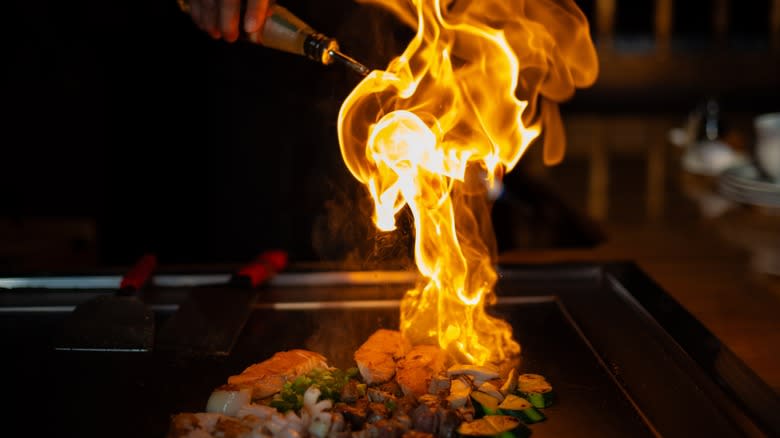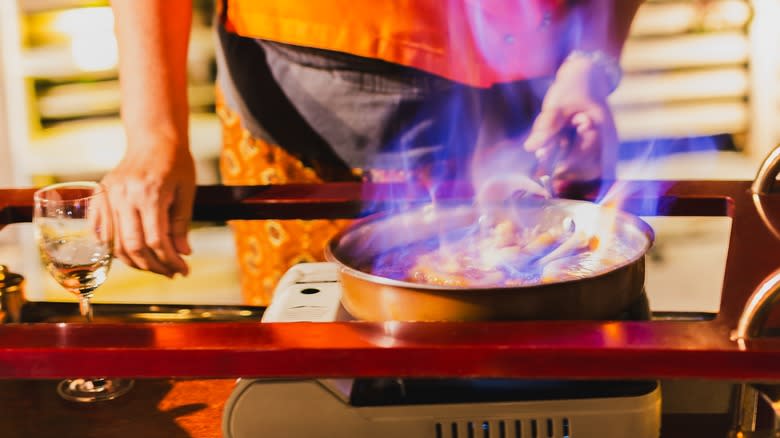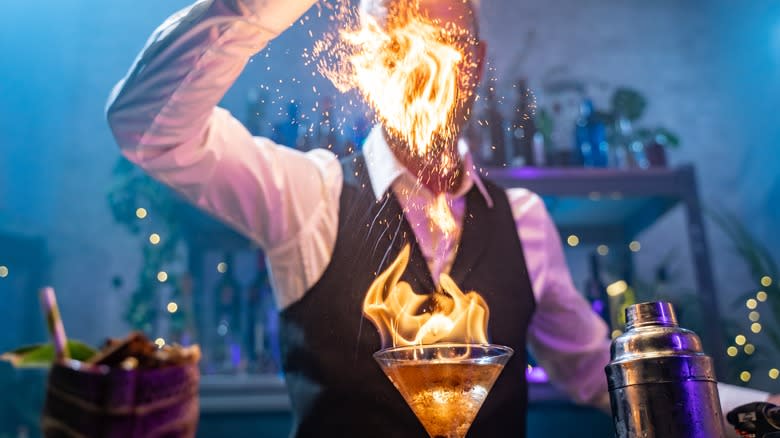An Essential Flambé Safety Tip You Need To Keep In Mind

Lighting your desserts on fire isn't a trick that inexperienced chefs should mess around with. But if you're confident enough in your cooking skills to work with an open flame that isn't connected to a stove, flambéing is a great way to add flair and extra flavor to bananas foster or cherries jubilee. But fire is fire, and when you're adding liquor to a dish and setting it on fire, you need to pay close attention and keep safety in mind.
One tip in particular can help to control your flame a little more: Measure out how much liquor you need in a separate cup before you pour it into the pan on the stovetop. Don't just pour straight from the bottle into the pan. This way, you won't risk making your flame too large or too small if you don't eyeball the measurement correctly. More importantly, it can help you avoid any splashes of flammable alcohol that can catch fire too soon. Once you've measured, pour the alcohol carefully out of the measuring cup and into the pan.
Read more: 11 Of The Best Cooking Tips From Bobby Flay
Cooking With (More) Fire

When it comes to setting the flame, you should strongly consider using a utility lighter (or a grill lighter or a candle lighter, which are all about the same) if you're planning to flambé food. Unlike a normal gas station lighter -- where the open flame is inches from your not-so-fireproof fingers -- utility lighters have a long neck that ensures the flame is much farther from your hand. This is also much safer than tipping the pan toward the flame to start the fire.
As for the alcohol itself: To safely flambé liquor, you should stick to alcohol between 80 and 120 proof, or 40% to 60%. Most spirits fall into this range, but it's still something to think about rather than picking drinks at random. You shouldn't need to add more than 1 tablespoon of liquor per serving.
Finally, always let the dish cook until the flame dies out on its own. If the flame gets out of hand, keep a pan lid nearby to cover it up, and know where your nearest fire extinguisher is. Flambéing isn't complicated, but it still requires focus.
Why Use Fire?

It's commonly assumed that the only reason to flambé a dish is to make it look more impressive to onlookers. And make no mistake: Looking cool is part of why you do it, and there's no shame in that. But there are practical reasons for doing it, too.
By setting the liquor on fire, you're keeping part of the liquor's flavor while cooking off some of the alcohol with the flame. Flambéing liquor doesn't remove all of the alcohol, but it burns off enough to give the liquor a slightly mellower flavor to whichever liquor you choose. Cognac and other types of brandy are popular choices for a flambé. But some prefer rum or whiskey.
It's most commonly used for fruity desserts, but sometimes savory dishes like steak Diane or fish flambé call for it too. You can also flambé certain drinks (since the alcohol is already there), like tiki drinks or even flaming Dr. Pepper shots. Just keep these flambé tips in mind, especially if you're drinking.
Read the original article on Daily Meal.
